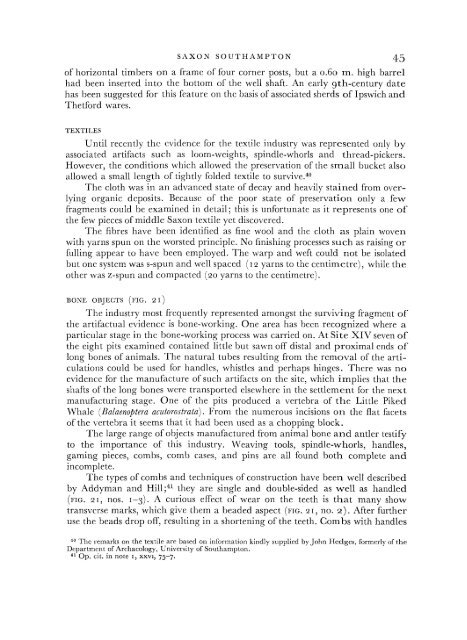Saxon Southampton; a New Review - Archaeology Data Service
Saxon Southampton; a New Review - Archaeology Data Service
Saxon Southampton; a New Review - Archaeology Data Service
You also want an ePaper? Increase the reach of your titles
YUMPU automatically turns print PDFs into web optimized ePapers that Google loves.
SAXON SOUTHAMPTON 45<br />
of horizontal timbers on a frame of four corner posts, but a 0.60 m. high barrel<br />
had been inserted into the bottom of the well shaft. An early 9th-century date<br />
has been suggested for this feature on the basis of associated sherds of Ipswich and<br />
Thetford wares.<br />
TEXTILES<br />
Until recently the evidence for the textile industry was represented only by<br />
associated artifacts such as loom-weights, spindle-whorls and thread-pickers.<br />
However, the conditions which allowed the preservation of the srnall bucket also<br />
allowed a small length of tightly folded textile to survive.t"<br />
The cloth was in an advanced state of decay and heavily stained from overlying<br />
organic deposits. Because of the poor state of preservation only a few<br />
fragments could be examined in detail; this is unfortunate as it represents one of<br />
the few pieces of middle <strong>Saxon</strong> textile yet discovered.<br />
The fibres have been identified as fine wool and the cloth as plain woven<br />
with yarns spun on the worsted principle. No finishing processes such as raising or<br />
fulling appear to have been employed. The warp and weft could not be isolated<br />
but one system was s-spun and well spaced (12 yarns to the centimetre), while the<br />
other was z-spun and compacted (20 yarns to the centimetre).<br />
BONE OBJECTS (FIG. 2 I)<br />
The industry most frequently represented amongst the surviving fragment of<br />
the artifactual evidence is bone-working. One area has been recognized where a<br />
particular stage in the bone-working process was carried on. At Site XIV seven of<br />
the eight pits examined contained little but sawn off distal and proximal ends of<br />
long bones of animals. The natural tubes resulting from the removal of the articulations<br />
could be used for handles, whistles and perhaps hinges. There was no<br />
evidence for the manufacture of such artifacts on the site, which implies that the<br />
shafts of the long bones were transported elsewhere in the settlement for the next<br />
manufacturing stage. One of the pits produced a vertebra of the Little Piked<br />
Whale (Balaenoptera acutorostrata). From the numerous incisions on the flat facets<br />
of the vertebra it seems that it had been used as a chopping block.<br />
The large range of objects manufactured from animal bone and antler testify<br />
to the importance of this industry. Weaving tools, spindle-whorls, handles,<br />
gaming pieces, combs, comb cases, and pins are all found both complete and<br />
incomplete.<br />
The types of combs and techniques of construction have been well described<br />
by Addyman and Hillr" they are single and double-sided as well as handled<br />
(FIG. 21, nos. 1-3). A curious effect of wear on the teeth is that many show<br />
transverse marks, which give them a beaded aspect (FIG. 2 I, no. 2). After further<br />
use the beads drop off, resulting in a shortening of the teeth. Combs with handles<br />
40 The remarks on the textile are based on information kindly supplied by John Hedges, formerly of the<br />
Department of <strong>Archaeology</strong>, University of <strong>Southampton</strong>.<br />
41 Op, cit. in note I, XXVI, 75-7.

















